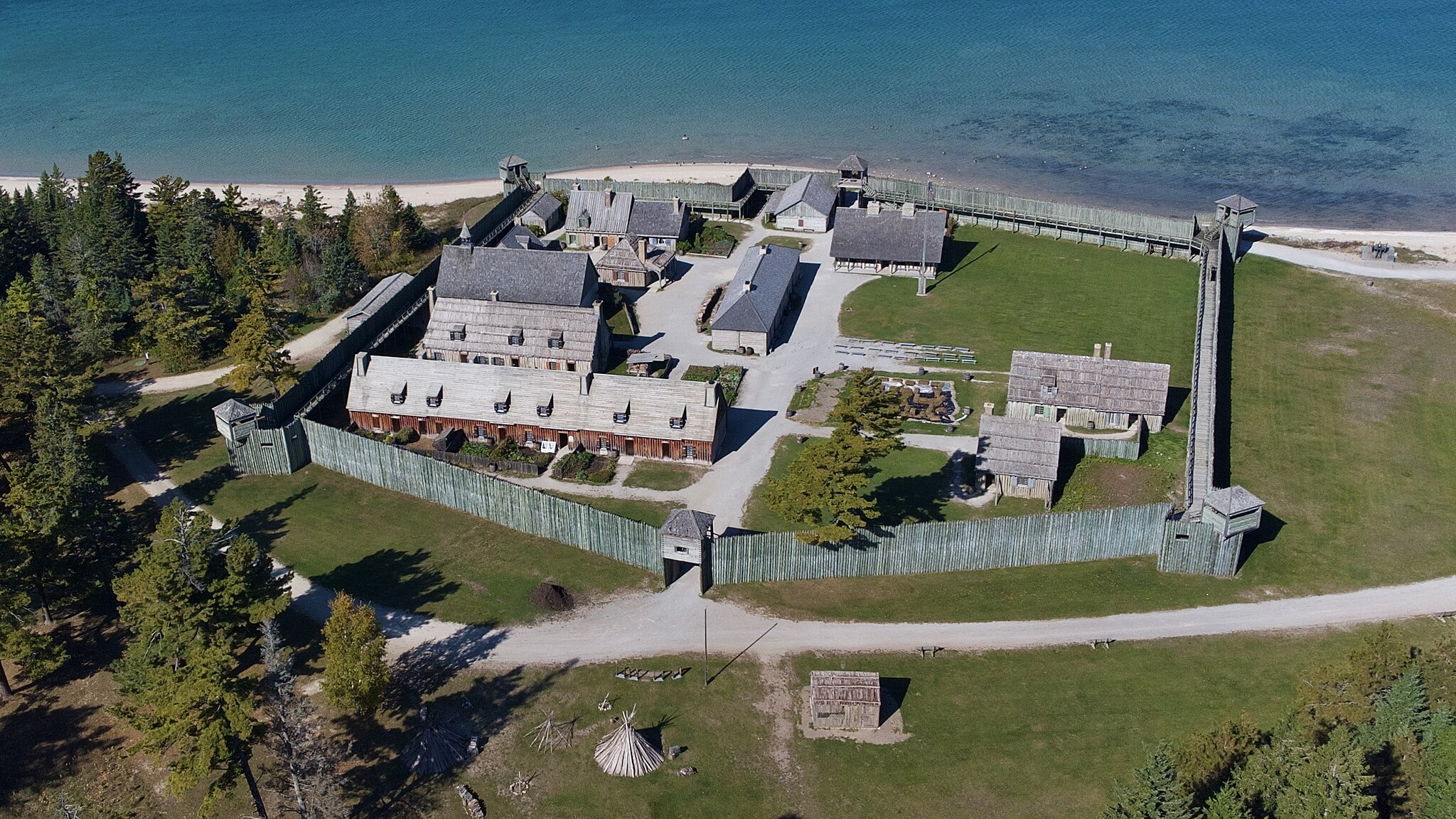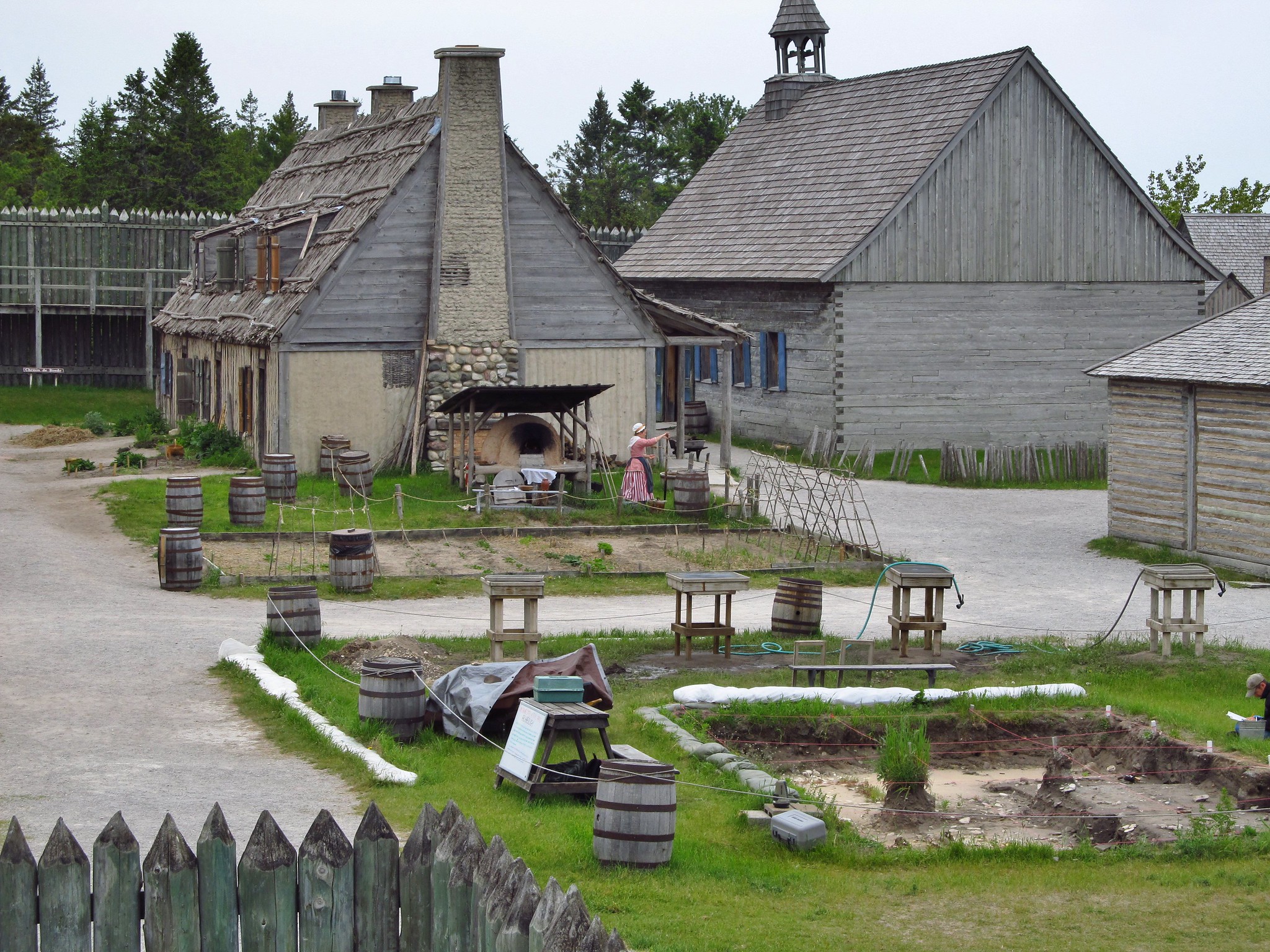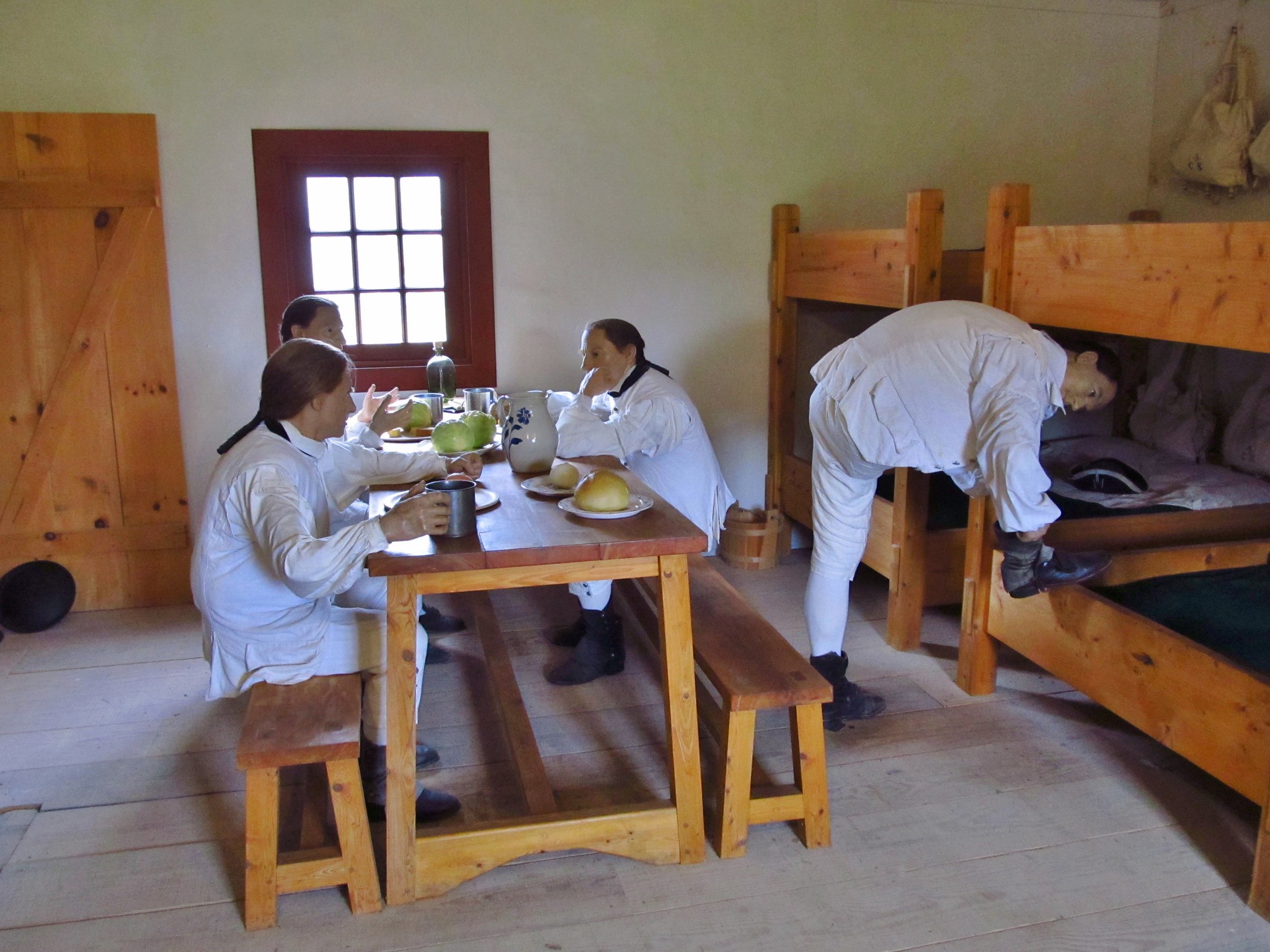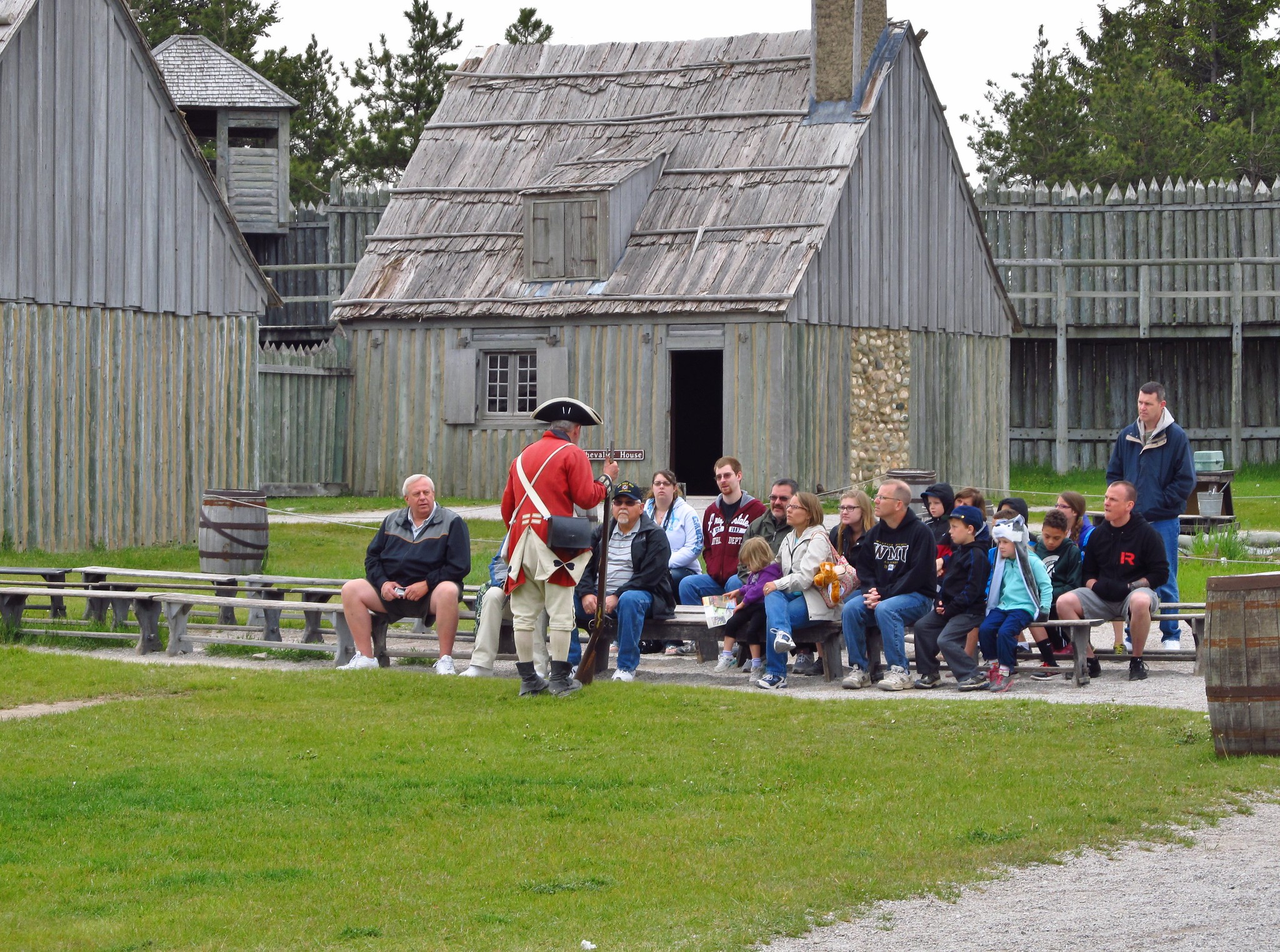Fort Michilimackinac is located on the south side of the Straits of Mackinac. It sits on a sand beach in the northernmost extension of the Lower Peninsula of Michigan. Michilimackinac was the second fort to guard the Straits of Mackinac. The fort was a key trade, military, and diplomatic post for the French (1715–61) and the British (1761–81). The fort’s buildings were moved by the British in 1780-1 to a more defensible location on Mackinac Island. Fort Michilimackinac was reconstructed in the 20th century and serves as a living history museum in Michigan.

French Period
In 1698, the French closed Fort de Buade, which was located on Moran Bay on the north shore of the Straits of Mackinac. They soon decided to reestablish a post, however, as the area continued to be occupied by the Odawa as well as French and Métis traders who refused to return to New France. The Jesuits also retained a presence at the Straits, even after shuttering their mission at St. Ignace in 1705. Coureurs des bois, unlicensed French traders, also continued to visit the Straits to rest and trade. Importantly, from the French authorities’ perspective, their absence allowed First Nations to develop trading relationships with English traders at Albany and in the Ohio country, and at posts of the Hudson’s Bay Company further north. The French therefore decided in 1710 to reestablish an official presence at the Straits of Mackinac.
The strategic importance of the Straits increased due to conflict with the Fox Nation (ca. 1710–40), whose territories included the western shores of Lake Michigan. Captain François-Marie Le Marchand de Lignery was therefore sent with a few regular soldiers and militia to the Straits in 1712. He and his troops probably occupied buildings in St. Ignace on the Straits’ northern shore.
Trade and Military Centre
In response to Fox attacks, Governor Vaudreuil sent a trade and military expedition to the Straits in 1716. The construction of Fort Michilimackinac probably began that summer. The fort consisted of a square stockade with four corner bastions. Four small brass canons were installed in the autumn of 1716 — the only artillery pieces under the French regime. The new fort, constructed on an exposed beach on the south side of the Straits of Mackinac, would serve as an entrepot of trade as well as the key French diplomatic and military site in the Upper Lakes. The fort was a staging ground for French and Indigenous military activities during the Fox Wars (ca. 1710–40); Chickasaw Wars (ca. 1721–63); Queen Anne’s War (1702–13), part of the War of the Spanish Succession); King George’s War (1744–48), also known as the War of the Austrian Succession; and the French and Indian War (1754–63) (see also Seven Years’ War).
As an entrepot, the fort was a permanent and seasonal residence for traders, a rendezvous for canoe brigades carrying goods from Montreal and those bringing furs from the interior, and a secure location to store goods, supplies, and peltries. The fort also served as a centre for the trade in Indigenous slaves, or Panis, and some enslaved Africans, between the Pays-d’en-Haut and colonial centres of Montreal, Trois-Rivieres, and Quebec.
During the French occupation of Fort Michilimackinac, the site was enlarged at least twice. These expansions were a direct result of the growing population at Michilimackinac due to the site’s military and trade importance. By 1749, the fort contained buildings for the military, row houses for French and Métis traders and families, a blacksmith shop, church, and priests’ residence.
In 1760, however, French forces in Montreal surrendered to the British, effectively completing the British conquest of New France. When news of the French surrender reached Michilimackinac’s commander, Captain Louis Liénard de Beaujeu de Villemonde, in the fall of 1760, he decided to leave rather than surrender to the British. Beaujeu, along with three officers, two cadets, 48 soldiers and 78 militiamen, left in October 1760 for the Illinois country. The fort was left in charge of a resident Métis trader and lieutenant in the colonial regulars, Charles Michel de Langlade. On 28 September 1761, Langlade formally relinquished the fort to British Captain Henry Balfour. Lieutenant Leslye of the 60th Regiment of Foot became the post’s first British commander on 1 October 1761. He was replaced in September 1762 by Captain George Etherington.

British Period
Fort Michilimackinac continued as a key military and trading post under the British. Under the terms of the 1760 capitulation, the French and Métis at the Straits were guaranteed religious freedom and allowed to retain their property. Life largely continued as it had under French occupation. However, British policies led to conflict with First Nations: they restricted goods such as firearms and ammunition and failed to engage in gift-giving, which was necessary to secure consent to their occupation of the forts and engage in ongoing relationships. These policies contributed to hostilities throughout the interior, known as Pontiac’s War (1763-66).

Fort Michilimackinac Captured
The most dramatic event in the fort’s history came on 2 June 1763, when it was captured by the Anishinaabe war chief Minavavana (Minweweh) as part of Pontiac’s War. There had been rumours of an impending attack, which Charles Michel de Langlade brought to the attention of the fort’s commander, Captain George Etherington. Despite the warning, Etherington accepted a proposal by Anishinaabe and Sac warriors to hold a game of baaga’adowe near the fort in honour of King George III’s birthday. (See also Lacrosse.) Etherington allowed the fort’s gates to remain open while unarmed soldiers watched the event.
During the game, the ball was tossed over the stockade and into the fort. As the players ran toward the gates, women handed concealed weapons to the men who entered the fort. The warriors killed 22 soldiers, including Lieutenant John Jamet, and a trader named Tracey. The rest of the garrison (including the commanding officer) were taken prisoner, five of whom where later killed by the Anishinaabe. Alexander Henry, an English trader, was taken prisoner and subsequently rescued by Ojibwa chief Wawatam, with whom he remained until 1764. (Henry’s published vivid account of the attack is a key source for the popular understanding of these events.) The surviving English soldiers and remaining traders were eventually allowed to leave for Montreal on 18 July 1763 under an Odawa escort. The French and Métis at Michilimackinac cared for the fort until the British reoccupation.
Re-occupation by the British
In 1764, the British reoccupied Fort Michilimackinac. A contingent of 80 soldiers and officers took control of the fort in September. News of the peace between Britain and France, the terms of the Royal Proclamation of 1763, and a lack of trade goods all contributed to Indigenous consent to the reoccupation of interior forts in 1764. (See Treaty of Niagara 1764.) From 1764 until the 1781 abandonment of the fort, Michilimackinac assumed more of a military air than during French occupation. All trade was banned inside the fort and no more than 10 First Nations people were allowed inside at any time. The stockade and various other buildings were also repaired to strengthen its defenses. Finally, the increased size of the garrison led the British to requisition French homes for soldiers. This gradually led to the establishment of a small French and Métis village outside of the walls.
Yet Michilimackinac continued to be a key trading entrepot and rendezvous for traders from Montreal, the Upper Lakes, Ohio and Illinois Country, and the regions north and west of Lake Superior. As in the French era, the fort continued to offer protection to traders as well as their supplies and peltries. Likewise, the use of slave labour continued throughout the British period (although some slaves were also freed in both the French and British periods).
The final expansion and development of Fort Michilimackinac began in 1766. By 1775, the fort had assumed a general hexagonal shape that contained a new barracks, guard house, commander’s house, store house, expanded magazine and parade ground, church, priest’s residence, and various private dwellings.

American Revolution
During the American Revolution, Fort Michilimackinac served as a recruiting and staging ground for warriors allied with the British. For instance, warriors were dispatched in 1776 to help retake Montreal but arrived too late to participate in the fighting. Additionally, warriors from Michilimackinac in 1777, 1778, and 1779 participated in campaigns in upstate New York, the anticipated defense of Detroit, and the raid on St. Louis.
American successes south of Lake Michigan led Patrick Sinclair, the newly appointed Lieutenant Governor and superintendent of Michilimackinac, to strengthen British defenses on the Straits of Mackinac. Shortly after his arrival in October 1779, Sinclair decided to move the fort to Mackinac Island. Fort Michilimackinac had several drawbacks: as a wood fort situated on a beach, it was directly exposed to the storms and wave action, requiring constant repair of the buildings and stockade. Additionally, the stockade on one side was overlooked by a series of sand dunes that reformed after every attempt to remove them. The fort was also close to the water’s edge, making it vulnerable to ship bombardment.
The relocation to Mackinac Island began in the winter of 1779–80 and continued until the summer of 1781. Sinclair moved salvageable buildings from Michilimackinac to the island while employing soldiers, traders, and residents in building a new stone fort on the island’s bluff. By the summer of 1781, when the new fort was able to accommodate the garrison, the British flag and remaining troops were transferred to Fort Mackinac. After their departure, the British burned the remaining buildings and stockade, leaving the remnants to the shifting sands of the Straits.

State Park and Museum
After the removal of buildings and burning of Fort Michilimackinac the site remained abandoned until the late 19th century. The village of Mackinaw City transferred the site to Michigan in 1904, making it the second state park after Mackinac Island. In the 1930s, the picket walls of the fort were re-erected as part of a Depression-era work project. In 1959, professional archeologists and historians began systematically studying the remains and documents in order to begin reconstruction of the fort, and in 1960, the area was designated a National Historic Landmark. As of April 2024, approximately 60-65 per cent of the buildings within the walls of the fort had been reconstructed. Colonial Michilimackinac, a reconstructed fort as it existed in 1781, is a living history museum. Interpreters in period costumes demonstrate life on the frontier while museum displays highlight the French and British periods, the history of the trade in furs and slaves, as well as ongoing archaeological excavations.

 Share on Facebook
Share on Facebook Share on X
Share on X Share by Email
Share by Email Share on Google Classroom
Share on Google Classroom






